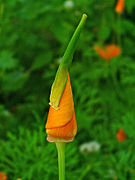Kalyptra
Kalyptra is a botany term that is used for various terms. In a broader sense it means a cover, hood, cap or lid for an organ or a body.

Mosses
In mosses Kalyptra denotes a hood, which in many mosses the capsule contributes covered and to protect them, it lies on the operculum ; the lid of the sporangium . It arises from the fact that the sporophyte at the beginning of its growth tears off the tissue of the gametophyte in which it originated (usually this will be the archegonia neck ) and carries a piece of it upwards.
The kalyptra can be formed very differently. With some mosses it consists of a kind of felt, with others it is a membranous cap, with others it falls off quickly.
Seed plants
In the case of seed plants, the word kalyptra refers to a root cap . It serves here as protection of the root vegetation point when penetrating into the ground. Furthermore, the penetration into the soil is facilitated by mucous cells.
Also, it refers to a compact hood, protective fabric (flowers cap buds cap) for dust and carpels which drops at flowers at a particular stage of development, such. B. with the eucalyptus (here also operculum), the genus Eschscholzia or with grapevines .
It can consist of the overgrown gamosepal sepals (calycine) and / or the gamopetal petals (coralline). A pseudocalyptra is when the free petals or sepals overlap during development and their surfaces adhere tightly so that they fall as a unit that resembles a fused flower envelope, as in Syzygium species or the eucalyptus.
Cleistocarp sporophyte of Physcomitrella patens . The kalyptra sits on the brown spore capsule. The brownish colored archegonia neck can be seen
Wall-toothed moss kalyptra ( Tortula muralis )
Still closed flower of Eschscholzia californica with later sloping calyptra at the top
See also
- Calyptra (disambiguation)
Individual evidence
- ^ Ralf Reski : Development, genetics and molecular biology of mosses. In: Botanica Acta. 111, 1998, 1-15.
- ↑ Peter K. Endress: The evolution of floral biology in basal angiosperms. In: Philos. Trans. R. Soc. Lond. B Biol. Sci. 365 (1539), 2010, pp. 411-21, doi : 10.1098 / rstb.2009.0228 .
- ^ G. Prenner et al .: Correcting Phylogenetic Signal of Homoplastic Traits: The Evolutionary History of Perianth Fusion in Myrtaceae. XIX International Botanical Congress (IBC), 2017, doi : 10.13140 / RG.2.2.34889.03687 .
- ↑ Thais Nogales da Costa Vasconcelos: Morphological homogeneity, phylogenetic heterogeneity and systematic complexity in species-rich groups: a case study of floral evolution in Myrteae (Myrtaceae). Thesis, University College London, 2017, online (PDF; 17.7 MB), from UCL Discovery, accessed October 18, 2018 ..




